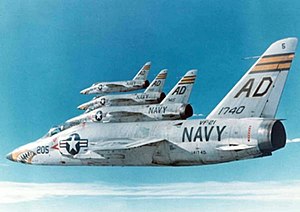| F11F/F-11 Tiger | |
|---|---|
 VF-21 F11F-1 Tigers in left echelon formation | |
| General information | |
| Type | Fighter aircraft |
| Manufacturer | Grumman |
| Status | Retired |
| Primary user | United States Navy |
| Number built | 199[1] |
| History | |
| Manufactured | 1954–1959 |
| Introduction date | 1956 |
| First flight | 30 July 1954 |
| Retired | 1961 (Carrier) 1967 (Training) 1969 (Blue Angels) |
| Variants | Grumman F11F-1F Super Tiger |
The Grumman F11F/F-11 Tiger is a supersonic, single-seat carrier-based fighter aircraft designed and produced by the American aircraft manufacturer Grumman. For a time, it held the world altitude record of 76,939 feet (23,451 m), as well as being the first supersonic fighter to be produced by Grumman.[2]
Work on what would become the Tiger commenced in 1952 as a design study, internally designated G-98, to improve the F9F-6/7 Cougar. However, the resulting design produced had little association with the Cougar by the end of the project. The U.S. Navy Bureau of Aeronautics placed order for two prototypes, initially designated XF9F-8. On 30 July 1954, the first prototype performed its maiden flight, during which it almost achieved Mach 1; the second prototype became the second U.S. Navy aircraft to exceed the speed of sound. On 21 September 1956, the Tiger became the first jet aircraft to shoot itself down. Originally designated the F11F Tiger in April 1955 under the pre-1962 Navy designation system, the aircraft was redesignated as F-11 Tiger under the 1962 United States Tri-Service aircraft designation system. A total of 199 Tigers were produced for the United States Navy, with the last aircraft being delivered to the service on 23 January 1959.
The Tiger entered service with the U.S. Navy during 1956, and was flown from the carriers Intrepid, Lexington, Hancock, Bon Homme Richard, Shangri-La, Forrestal, Saratoga and Ranger. Frontline use of the Tiger was relatively brief, largely due to its performance being inferior to the competing Vought F-8 Crusader, such as its limited endurance, while its Wright J65 turbojet engine had also proved to be somewhat unreliable. Through to the late 1960s, the aircraft used flown by the Naval Air Training Command in South Texas at NAS Chase Field and NAS Kingsville, to give students experience of supersonic flight. Between 1957 and 1969, the Tiger was used by the Blue Angels flight team, being eventually replaced by the McDonnell Douglas F-4 Phantom II. The last examples were withdrawn from U.S. Navy service during 1969, although a handful of aircraft remained operational and were conducting test flights as late as 1975.
- ^ Green 2015, p. 116.